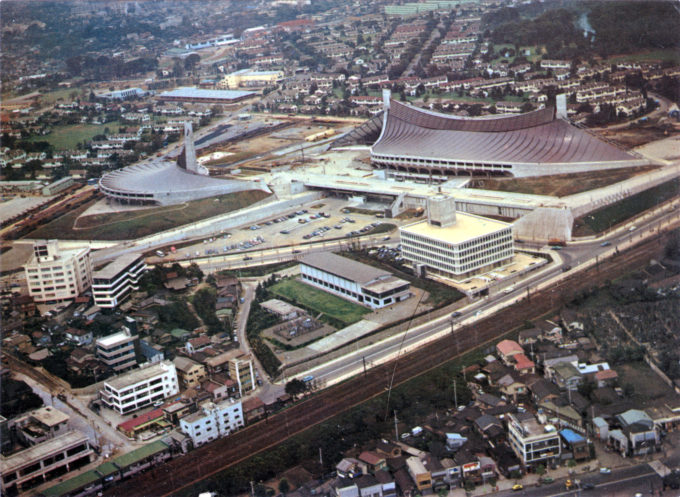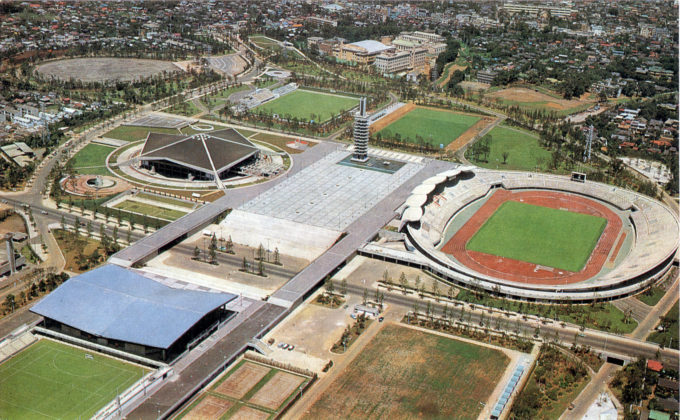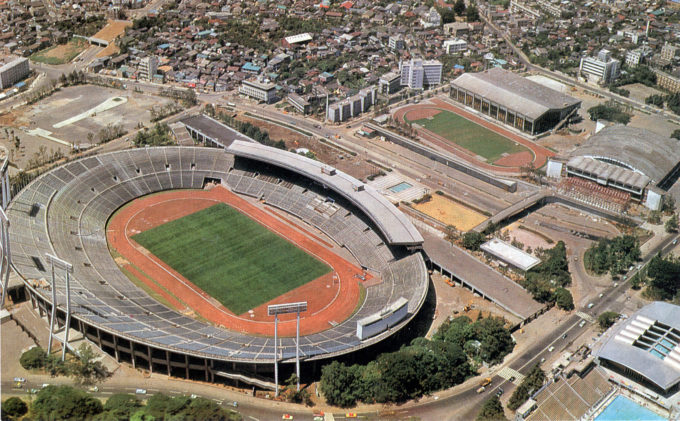From the wiki: “Tokyo was selected in 1936 to host the 1940 Summer Olympics, but had to withdraw its hosting duties upon Japan’s second invasion of China in the following year. This led the organizing committee to abandon organizing the 1940 Games altogether in 1938 with them being awarded to Helsinki though the Finnish city would abandon the 1940 Games themselves in the wake of World War II.
“After being excluded from the 1948 Summer Olympics due to its involvement in World War II, Japan launched their Olympic bid in 1950 and the capital, Tokyo, was selected in 1959 to host the 1964 Summer Games.”
- 1964 Tokyo Olympic Games.
- 1964 Tokyo Olympic Games.
- 1964 Tokyo Olympic Games.
See also:
Olympic Village née Washington Heights Housing Complex, Tokyo, 1964
Meiji Jingu Outdoor Swimming Pool, Tokyo, c. 1935.
Meiji Shrine Games, Tokyo, 1926.

“Anchorman Yoshinori Sakai holds aloft the Olympic torch as he set ablaze the cauldron”, Tokyo, 1964. Sakai, nicknamed ‘Atom Boy’ by the Japanese press, was born in Hiroshima on the day the city was atom-bombed (August 5, 1945), and was chosen to light the cauldron to symbolize Japan’s postwar reconstruction and peace.
“One of the most poignant symbolic moments of the 1964 Opening Ceremonies was when Sakai Yoshinori, also known as ‘Atom Boy,’ lit the Olympic flame in the National Stadium. Sakai had been born in Miyoshi, Hiroshima Prefecture, on August 6, 1945, the day Hiroshima was leveled by an atomic bomb. In 1964, as a first-year student and aspiring sprinter at Waseda University, he was chosen as the final torchbearer to symbolize Japan’s postwar reconstruction and peace.”
– Japan in the Olympics, the Olympics in Japan, by Robin Kietlinski, 2016

Yoyogi National Gymnasium, Tokyo Olympics, 1964, designed by Kenzo Tange, and built between 1961 and 1964 to house swimming and diving events in the 1964 Summer Olympics. A separate, smaller annex of similarly-designed was used for the basketball competition at those same games. On the periphery of the stadium grounds can be seen units from the former Washington Heights US military housing base that would be used as the Olympic Village by athletes during the 1964 Summer Olympics.
“Together with a number of other important projects which Kenzo Tange carried out after 1959, the Olympic stadia in Tokyo can be regarded as the culmination of his career, designed in 1960 and built in 1964, on a par with the highest achievements of the Japanese tradition… The plan [of the larger stadium] is in the form of two semi-circles, slightly displaced in relation to one another, with their unconnecting ends elongated into points. The entrances are located in the concave sides. The roof is supported on two reinforced concrete pillars, and is made up of a system of steel cables onto which enameled steel plates are then soldered. The curving form of the roof serves to make it more resistant to wind, which can reach hurricane force in this region. ”
– Kenzo Tange: Works and Projects, Udo Kultermann, 1989

Map: Washington Heights military housing location (1946-1962), relative to Yoyogi and Shibuya stations and Meiji Shrine, c. 1949.
The Yoyogi Olympic complex was built on the grounds of the former US military housing estate called Washington Heights. The area had formerly been used as a parade ground by the Imperial Japanese Army. After Japan’s surrender in 1945, the Occupation forces ordered the construction of the Washington Heights complex by the Japanese government for use by the US military. Housing totaled 827 units for United States Army Air Force and, later, Air Force personnel and their families. The US maintained control of it after the signing of the Treaty of San Francisco (1952) until it was determined that the grounds were needed for construction of the Yoyogi Olympic complex.
During the Games, a number of the family housing barracks were used as athlete housing (seen on the periphery of the stadiums above). After the Olympics, the remainder of the Washington Heights housing was razed – with the exception of one house (that had been used by the Dutch Olympic team). It remains standing today in Yoyogi Park as an 1964 Summer Games memorial.
- Yoyogi Olympic stadiums, Yoyogi, 1964. The National Gymnasium (right) was used for swimming and diving competition, while the Annex (left) was the basketball venue. Both buildings were designed by Kenzo Tange.
- Aerial view of stadiums and Olympic Village, Yoyogi, 1964. In the distance can be seen the former Washington Heights housing, used by athletes during the Tokyo Olympics.
Komazawa Olympic Park (below), straddling the western Tokyo suburban wards of Meguro and Setagaya, includes an outdoor athletic and soccer venue, the Komazawa Olympic Park Stadium, the Komazawa Gymnasium and multiple additional soccer, baseball, swimming, tennis, jogging and cycling facilities – along with the landmark Control Tower, that features as a focal point of the park – all designed by Japanese architect Yoshinobu Ashihara. The gymnasium venue hosted the wrestling events at the 1964 Summer Olympics. Three field hockey fields were also built, marking the first time field hockey was played at one single Olympic venue since the 1920 Games.
- Komozawa Olympic Park, 1964.
- Komazawa Olympic Park, c. 1964.
National Stadium (below) is a stadium Meiji Shrine Outer Garden on the site of the former Meiji Field. The new stadium served as the venue for the Olympic Games opening and closing ceremonies, as well as being the venue for track and field events. The stadium was completed in 1958. Its first major hosting event was the 1958 Asian Games.
- National Stadium, Meiji Outer Garden, c. 1964.
- National Stadium, Meiji Outer Garden, 1964.
The Nippon Budokan
The Nippon Budokan was constructed for Judo competition in the 1964 Summer Olympics; hence its name, which translates in English to “martial arts hall”. It has since gone on to become well-known as the location where many “Live at the Budokan” albums were recorded, including those of Bob Dylan, Cheap Trick, Dream Theater and Ozzy Osbourne. The Beatles were the first rock group to perform at Budokan, and their appearances were met with opposition from those who felt the appearance of a Western pop group defiled the martial arts arena.
The Nippon Budokan is located in Kitanomaru Park in the center of Tokyo, on the north fringe of the Imperial Palace grounds near Yasukuni Shrine. The imposing octagonal structure holds 14,471 people, and was modeled after Yumedono (Hall of Dreams) in Hōryū-ji Shrine in Nara.
The National Memorial Service for War Dead is held annually on August 15, the day of Japan’s surrender, with the Prime Minister, the Emperor and the Empress in attendance.
Olympic Yacht Harbor, Enoshima















Pingback: Meiji Jingu Base-Ball Ground, c. 1930. | Old Tokyo
Pingback: Expo ’70, Osaka, 1970. | Old Tokyo
Pingback: Olympic Village née "Washington Heights" US Military Housing Complex, Tokyo, 1964. | Old Tokyo
Pingback: Kengo Kuma - “Make architecture disappear" - Sticks & Stones
Pingback: Olympic Disruption: The Give and Take of the World’s Games – The Wisconsin International Review